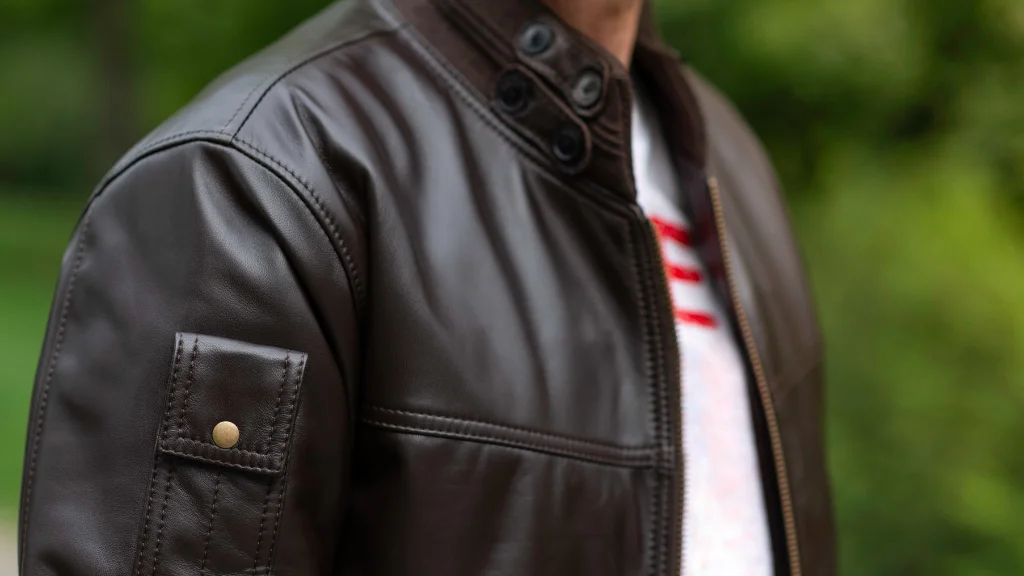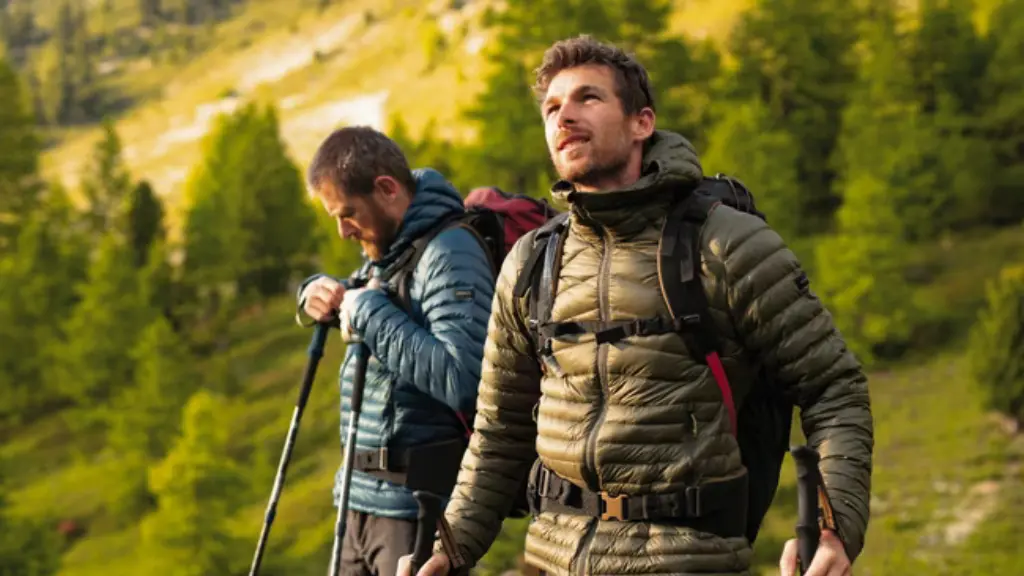Chances are you’ve come across the age-old debate of whether leather jackets are suitable for hiking or not. While some people swear by their leather jackets on the trails, others argue that synthetic materials are a better choice.
So who’s right? Let’s dive into the discussion and find out.
Are Leather Jackets Good for Hiking?

Leather jackets are generally not good for hiking. While stylish and great for a night out or a casual day in the city, they fall short in several key areas while hiking, such as weight, flexibility, breathability and water resistance.
- Weight: Leather jackets are HEAVY. When you’re climbing up a steep hill or trekking for miles, every ounce counts. You don’t want your jacket weighing you down.
- Flexibility: Leather isn’t known for its stretchiness. Hiking demands a lot of movement, and you need clothing that moves with you, not restricts you.
- Breathability: This is a big one. Leather jackets don’t breathe well. When you’re working up a sweat, you want a jacket that lets your body cool down, not traps the heat in.
- Water Resistance: With proper treatment, leather can repel water to some extent but it’s not naturally waterproof. Get caught in a downpour and you might end up soaked.
I’m not saying leather jackets have no place in the great outdoors. On a short, leisurely hike with clear skies forecasted, and maybe a stylish photo op in mind, sure, rock that leather jacket.
But for any serious hiking, especially in unpredictable weather, there are better options out there. Opt for lightweight, breathable, and water-resistant materials like synthetics or specially designed outdoor fabrics.
Leather vs. Other Fabrics for Hiking Jackets
We already know that leather jackets are not the best choice for hiking. But how do they fare against other fabrics? Let’s take a closer look at some of the key factors.
Is Leather Too Heavy for Hiking?

Leather looks cool and it has that rugged, adventurous vibe. But leather jackets tip the scales at about 2.5 to 3.5 pounds. That’s like carrying a small tent on your back, just in jacket form!
On the flip side, synthetic jackets – those made from materials designed to be light and efficient – usually weigh less than 1 pound. The difference is pretty stark.
Does that extra weight really matter? Oh, it does. Let’s say you’re hiking up to a breathtaking viewpoint. Now add a couple of extra pounds. It’s not just about the climb, but rather how these extra pounds can tire you out faster, making your hike less enjoyable and more of a slog.
So, what’s the verdict? While I love the look of leather and the way it tells a story with every scuff and scratch, when it comes to hitting the trails, I’d lean towards a synthetic jacket, such as Outdoor Research SuperStrand or Patagonia Torrentshell 3L. They’re lightweight and won’t weigh you down unlike leather.
Can Leather Weather the Storm?
Unlike your go-to workout shirt, leather isn’t great at wicking away moisture. Water tends to linger in leather, making it heavy and uncomfortable to wear.
When Leather Gets Damp
Imagine your leather jacket getting drenched during a sudden downpour. Over time, frequent soakings can lead to the leather becoming stiff and brittle, losing its natural flexibility. Plus, when leather gets wet and then dries out, it can become cracked and damaged.
Synthetic materials, on the other hand, are typically designed to be water-resistant or even waterproof. This is ideal for unexpected showers or if your hike takes you through a waterfall-drenched canyon.
Can Leather Keep You Warm and Dry?
Breathability
Yes, leather has some natural breathability thanks to its pores, but compared to synthetic materials, it’s like comparing a stuffy room to a breezy balcony.
Synthetic materials are designed to let your skin breathe. They wick moisture away, keeping you dry and comfortable.
Leather tends to hold onto moisture, which can make you feel sweaty and sticky. Not ideal for hiking, that’s for sure.
Cold Weather Insulation
When the temperature drops, staying warm becomes the name of the game. Leather, down, and wool are all players here, but they play the game differently.
- Leather is like that friend who’s always a bit unprepared for the weather. It can block the wind, sure, but when it comes to real cold, it needs backup.
- Down is your reliable buddy who always knows how to stay warm. It traps heat like no one’s business but get it wet, and it’s game over.
- Wool, on the other hand, is that rugged, all-weather friend. Wet, dry, cold, it’s got you covered.
So, why doesn’t leather cut it below 5°C (41°F) without help? It’s all about insulation. Leather itself doesn’t trap air well, and trapped air is what keeps you warm. Without layers underneath, wearing leather in cold weather would be like wearing a t-shirt in the snow. Not the best idea.
This is where layering becomes your secret weapon. Throw a wool sweater or a down hiking vest under your leather jacket, and suddenly you’ve got the perfect cold weather combo. The leather blocks the wind while your layers trap heat and keep you cozy.
Is Leather Durable Enough for the Trails?

Leather’s got a rep for being durable, and for good reason. I’ve had a leather jacket that shrugged off scrapes and scratches like they were nothing. But leather is kind of high-maintenance and it needs a lot of TLC to stay in fighting form.
The Need for Regular Maintenance
Leather is skin and, just like your skin, it needs care to stay healthy such as conditioning, cleaning, and sometimes even professional help if things get rough. If you leave your leather jacket hanging out to dry, it’s going to get sad. Cracks, dryness, the works. And nobody wants that.
Now, let’s compare this to synthetic materials that are always ready to roll. Rain? No problem. Mud? Just wipe it off. They don’t ask for much, maybe a spin in the washing machine, and they’re good to go.
Is leather really worth the hassle for hiking? It depends on what you’re looking for. If you’re all about that rugged, classic look and don’t mind a bit of upkeep, leather could be your trail companion. Just remember to show it some love with regular maintenance.
If you’re more of a “grab and go” type, synthetic materials might be more suitable.
Best Practices for Leather Care
If you’re leaning towards leather, here are some quick tips to keep it trail-ready:
- Condition regularly: Think of it as moisturizing your jacket. It keeps it soft and prevents cracking.
- Clean gently: Wipe off that trail dust with a soft cloth. For tougher jobs, use a cleaner made for leather.
- Store properly: Hang it up in a cool, dry place. No crumpled heaps at the bottom of your closet!
Is Leather an Eco-Friendly Choice?
When you think about leather, images of rugged, durable jackets might come to mind. It’s the kind of material that seems to tell a story with every scratch and crease. But have you ever wondered about the journey it takes before ending up as part of your adventure wardrobe?
The Long Haul of Leather
Leather is often praised for its longevity. It’s not uncommon for a well-loved leather jacket to outlast its owner, making it a potentially sustainable choice over its lifetime.
But here’s the catch – getting to that point involves a pretty resource-intensive process. From the water and land needed to raise livestock, to the chemicals used in tanning, it’s a bit of a bumpy road.
Synthetics: A Different Kind of Footprint
Synthetic materials are versatile, often more affordable, and let’s not forget – waterproof. However, they’re not without their own environmental baggage.
Synthetics are typically derived from petroleum, and their production can be pretty energy-hungry. They’re not exactly champions at biodegrading, sticking around in landfills long after we’re done with them.
So, What’s a Hiker to Do?
On one hand, you’ve got leather with its durability but heavy environmental toll. On the other, synthetics offer weather resistance and versatility, yet they’re a nightmare for our landfills and oceans.
Here’s my take: it’s all about making informed choices and finding a balance that works for you and the planet. Consider these tips:
- Opt for responsibly sourced materials: Whether it’s leather or synthetics, look for products made with sustainable practices.
- Quality over quantity: Invest in gear that’s built to last, reducing the need for frequent replacements.
- Recycle and repurpose: Give your old gear a second life through donation or recycling programs.
Conclusion
Leather jackets shouldn’t be your first choice for hiking but it doesn’t mean you have to completely avoid them either.
On days when the weather is playing nice and my hike is more about catching up with friends in the park than conquering peaks, I might throw it on for that extra bit of style.
But when it comes down to serious hiking, where the terrain is tough, the weather is unpredictable, and the stakes are a bit higher, my leather jacket stays at home.

Lukas Heller
Hey there! I’m Lukas, co-founder of BigfootHiking.com, alongside my adventurous wife Martha. Originally from Germany, I landed in Phoenix, Arizona, in 2015, where I’ve been scouting out new trails ever since (though they’re getting scarce!). By day, I’m a software developer, but my heart belongs to hiking – I’m always plotting our next trip. When I’m not coding or on the trails, you’ll find me hanging out with our Pit Bull, Zeus.





